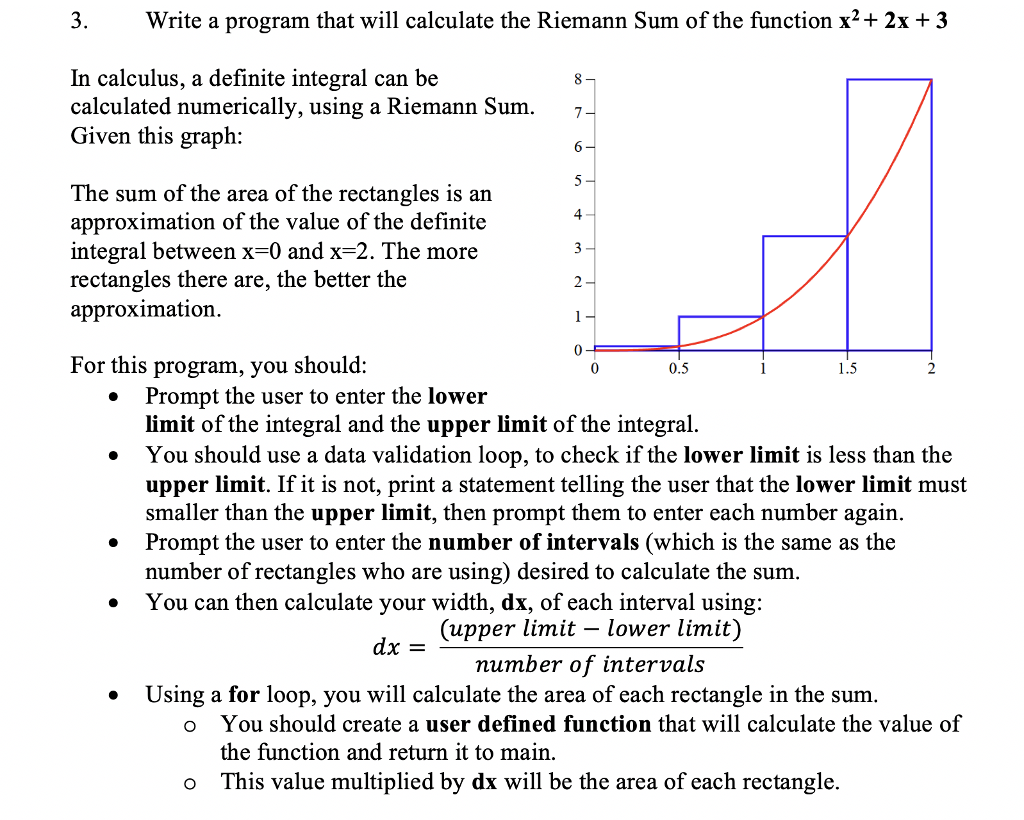Question
This program will hinge upon the setup of the for loop. In the graph above: The lower limit is zero.the upper limit is 2.and the

This program will hinge upon the setup of the for loop. In the graph above:
The lower limit is zero.the upper limit is 2.and the width, dx, is 0.5.
the area of the first rectangle would use the value of the function at x=0.5 multiplied by the width of the rectangle(which is 0.5).
The area second rectangle is calculated using the value of the function at x = 1 multiplied by the width of that rectangle(which is 0.5..the width of the rectangle is always the same in a particular problem).
The third rectangle would use the value of the function at 1.5the fourth would use the value of the function at 2.
So..you need to decide:
What value should my for loop start at? (what is the first value of x I need to use?)
What value should my for loop stop at? (what is the last value of x I need to use?)
What increment should I use in my for loop? (how much should I change each x in my problem)
Test your program with: lower limit of 0, upper limit of 4
Run it twice: once with 10 intervals, once with 200 intervals (same lower and upper limit)
Remember, this is an approximation. The actual value of the definite integral is 49.333
Please write the code in "printf" and "scanf" form, thank you.
Write a program that will calculate the Riemann Sum of the function x2+ 2x +3 In calculus, a definite integral can be calculated numerically, using a Riemann Sum.7 Given this graph: 6 The sum of the area of the rectangles is an approximation of the value of the definite integral between x-0 and x=2. The more rectangles there are, the better the approximation. 4 For this program, you should: 0.5 Prompt the user to enter the lower limit of the integral and the upper limit of the integral. You should use a data validation loop, to check if the lower limit is less than the upper limit. If it is not, print a statement telling the user that the lower limit must smaller than the upper limit, then prompt them to enter each number again. . Prompt the user to enter the number of intervals (which is the same as the number of rectangles who are using) desired to calculate the sum You can then calculate your width, dx, of each interval using: (upper limit - lower limit) number of intervals Using a for loop, you will calculate the area of each rectangle in the sum You should create a user defined function that will calculate the value of the function and return it to main This value multiplied by dx will be the area of each rectangle. o oStep by Step Solution
There are 3 Steps involved in it
Step: 1

Get Instant Access to Expert-Tailored Solutions
See step-by-step solutions with expert insights and AI powered tools for academic success
Step: 2

Step: 3

Ace Your Homework with AI
Get the answers you need in no time with our AI-driven, step-by-step assistance
Get Started


